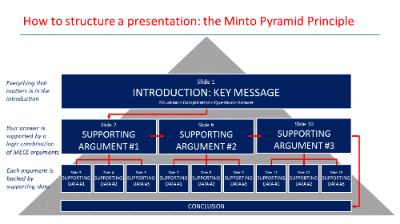The Pyramid Principle: A Detailed White Paper
Introduction
The Pyramid Principle, developed by Barbara Minto, is a powerful framework for structuring and communicating ideas effectively. It is based on the premise that the human mind naturally organizes information in a hierarchical structure, with the most important points at the top and supporting details below. By following this principle, we can create clear, concise, and persuasive messages that are easy to understand and remember.
Understanding the Pyramid Principle
The Pyramid Principle is built on three key concepts:
- Top-Down Structure: Ideas should be presented in a hierarchical order, with the most important point at the top and supporting details below.
- Logical Progression: The supporting points should logically flow from the main point and provide evidence or explanation.
- Pyramid Shape: The structure of the message should resemble a pyramid, with a broad base of supporting details and a narrow peak representing the main point.
The Pyramid Principle in Practice
To apply the Pyramid Principle, follow these steps:
- Identify the Main Point: Determine the central message or conclusion you want to convey.
- Develop Supporting Points: Identify the key points that support your main point. These should be directly related and logically connected.
- Provide Evidence: For each supporting point, provide specific evidence or examples to illustrate your point. This could include data, facts, anecdotes, or expert opinions.
- Organize the Information: Arrange your main point and supporting points in a pyramid structure, with the main point at the top and supporting details below.
- Use Clear and Concise Language: Express your ideas clearly and concisely, avoiding jargon or unnecessary complexity.
Examples of the Pyramid Principle in Action
Example 1: A Business Proposal
- Main Point: Our new product will increase sales by 20% in the next fiscal year.
- Supporting Points:
- Improved product features will meet customer needs more effectively.
- Increased marketing efforts will reach a wider audience.
- Our competitive pricing will attract new customers.
- Evidence:
- Market research indicates a strong demand for the product's features.
- Our marketing team has developed a successful campaign plan.
- Cost analysis shows that our pricing is competitive with similar products.
Example 2: A Presentation on Climate Change
- Main Point: Climate change is a serious threat to our planet and requires immediate action.
- Supporting Points:
- Rising sea levels are causing coastal flooding.
- Extreme weather events are becoming more frequent and severe.
- Biodiversity is declining due to habitat loss and climate change.
- Evidence:
- Scientific studies have documented the rise in sea levels.
- News reports describe the devastation caused by recent hurricanes and wildfires.
- Conservation organizations have identified the impact of climate change on endangered species.
Benefits of the Pyramid Principle
The Pyramid Principle offers several benefits for effective communication:
- Clarity: By organizing information in a logical structure, the Pyramid Principle makes it easier for the audience to understand and follow the message.
- Conciseness: The Pyramid Principle helps to eliminate unnecessary information and focus on the most important points.
- Persuasion: By presenting ideas in a clear and logical manner, the Pyramid Principle can be more persuasive than unstructured communication.
- Memorability: When information is organized in a pyramid structure, it is more likely to be remembered.
Conclusion
The Pyramid Principle is a valuable tool for anyone who wants to communicate effectively. By understanding and applying this framework, you can create clear, concise, and persuasive messages that are easy to understand and remember. Whether you are writing a business proposal, giving a presentation, or simply communicating with colleagues, the Pyramid Principle can help you achieve your goals.
References
- Minto, B. (1996). The Pyramid Principle: Logic in Writing and Thinking. Prentice Hall.
- [Insert additional references as needed]



